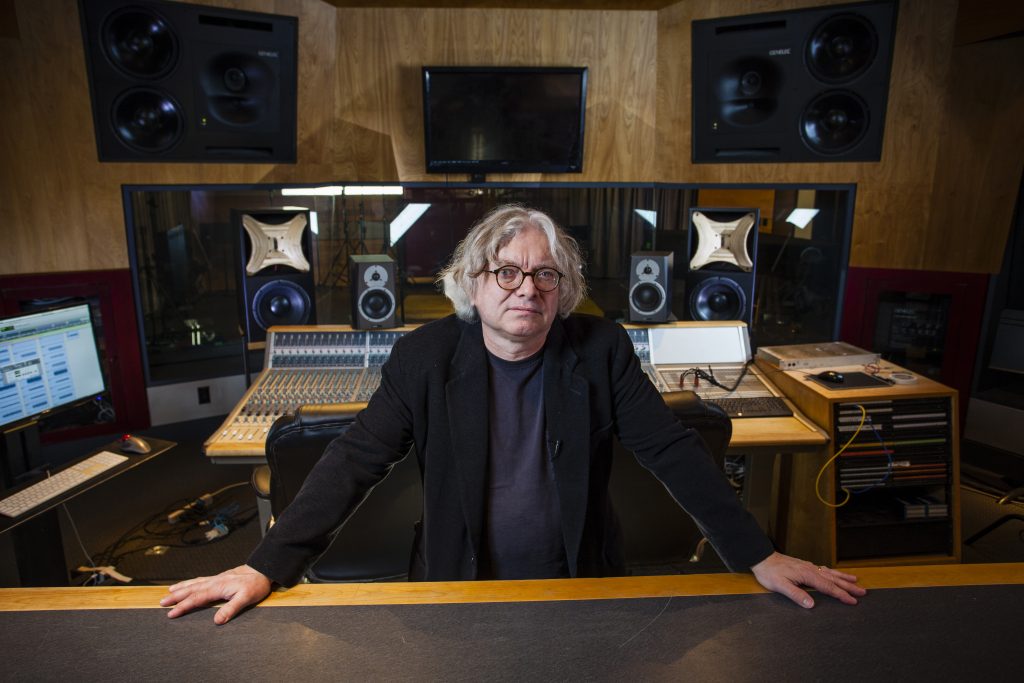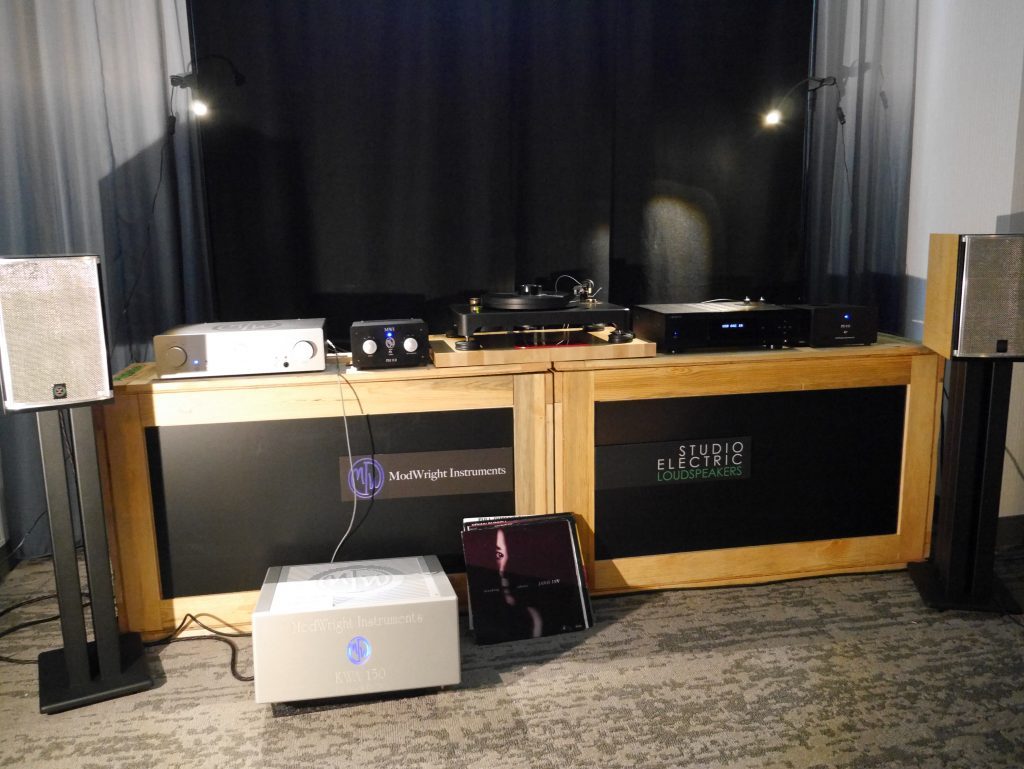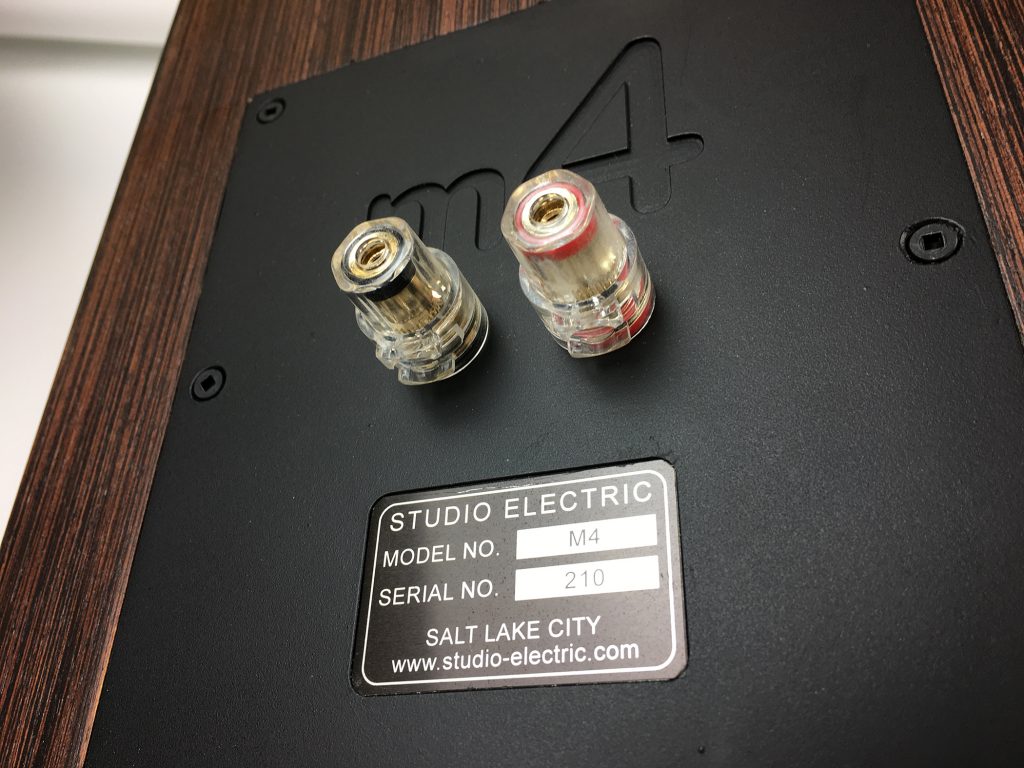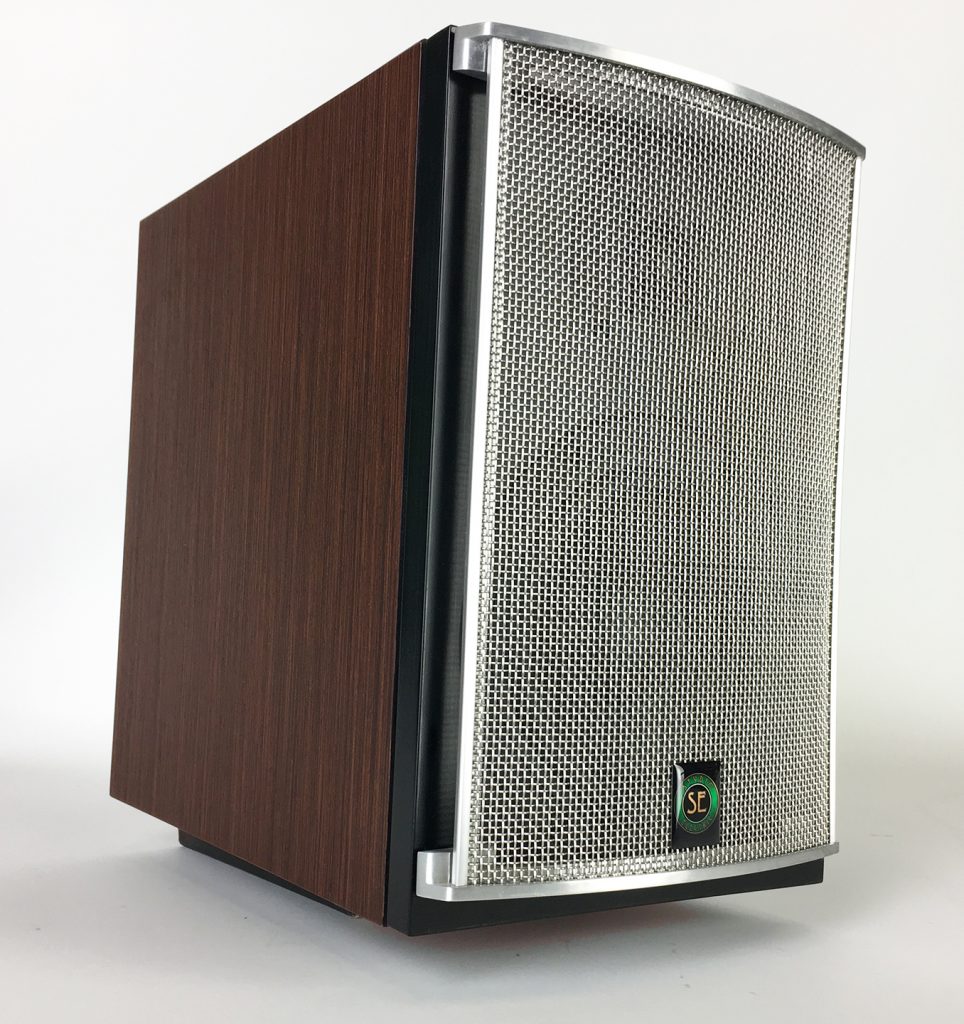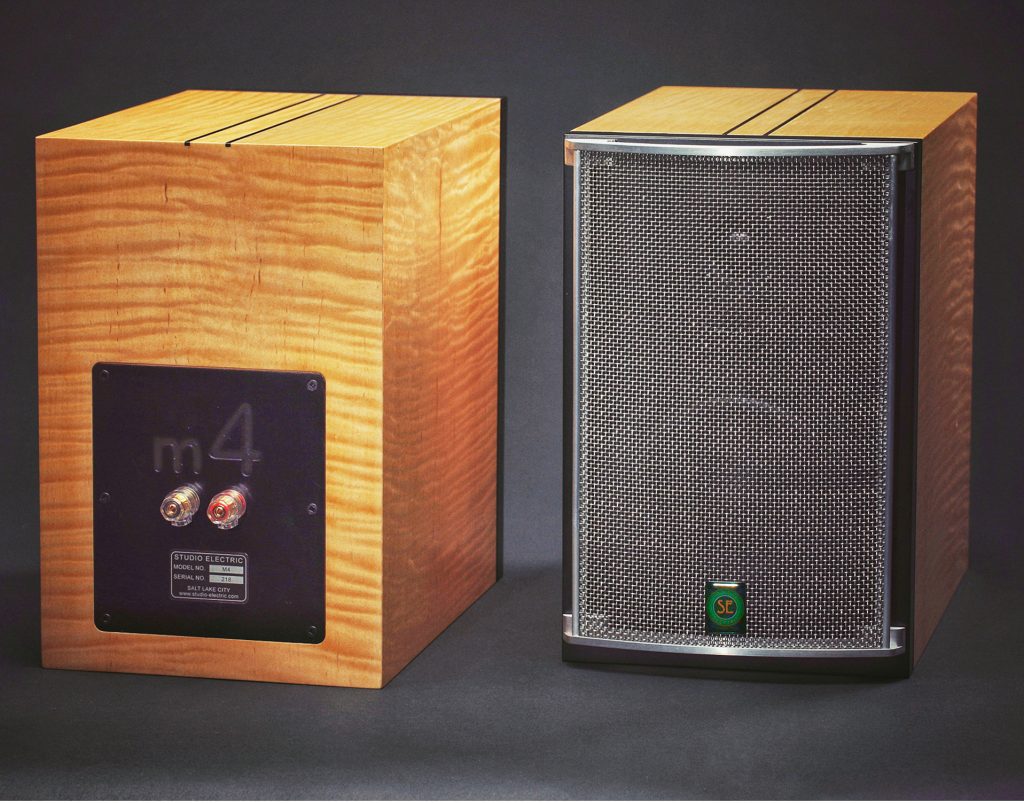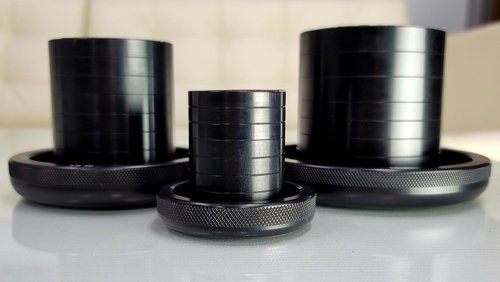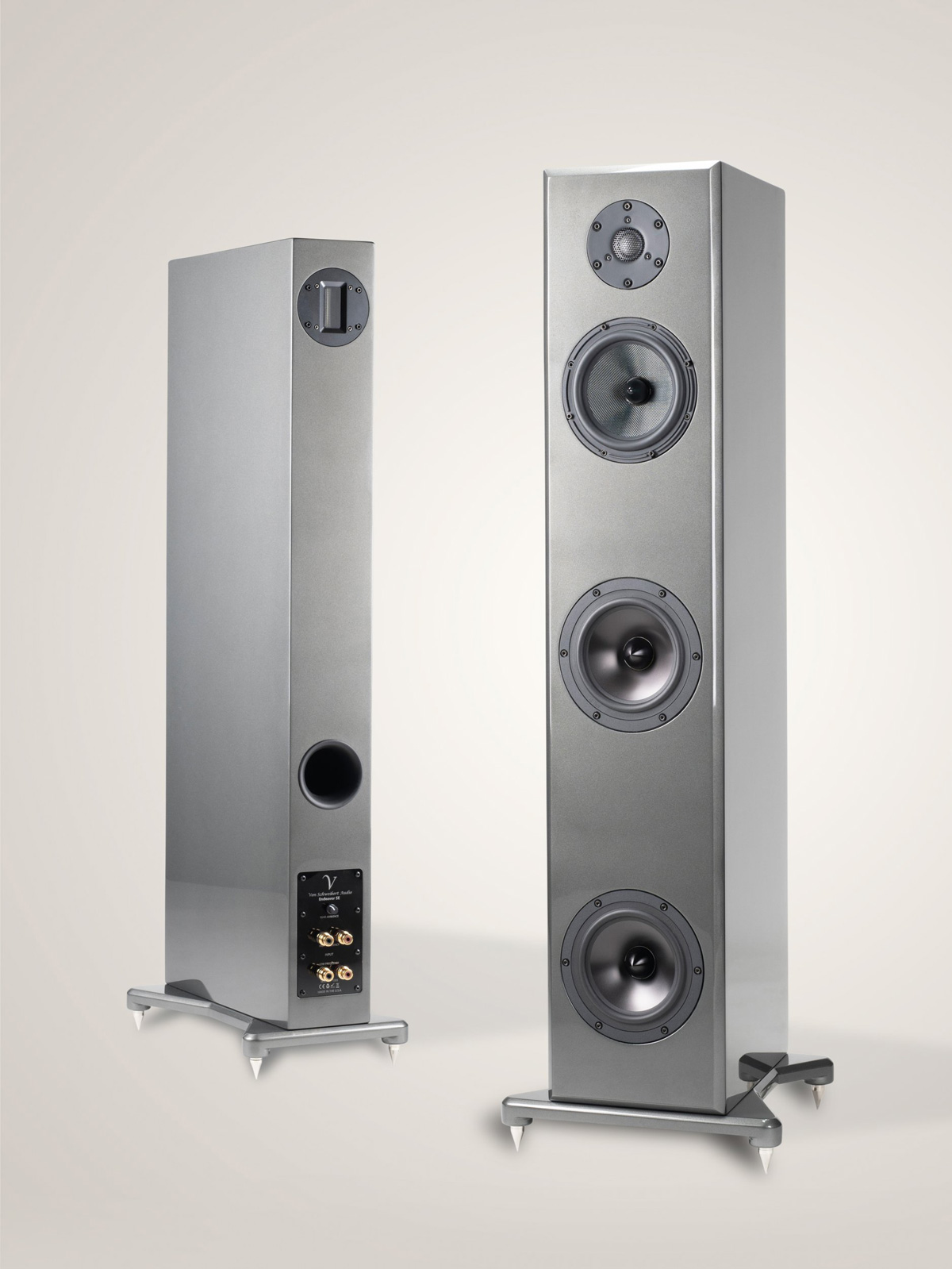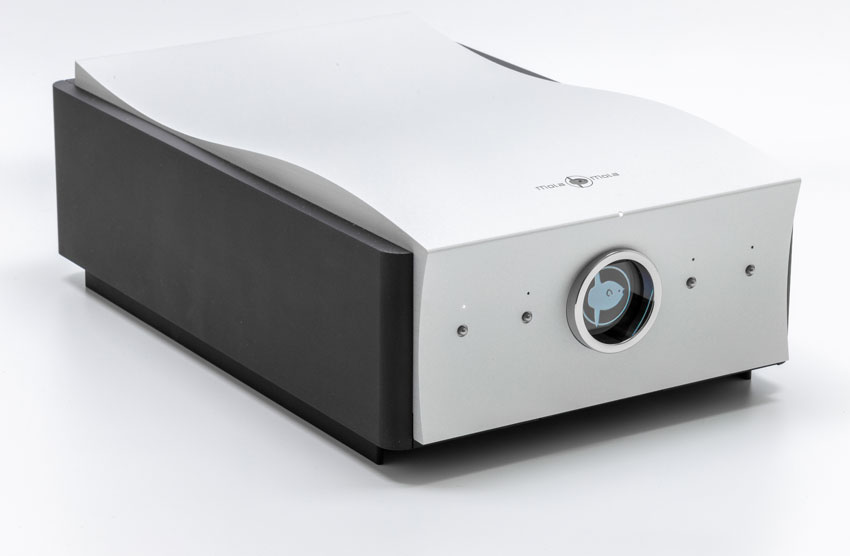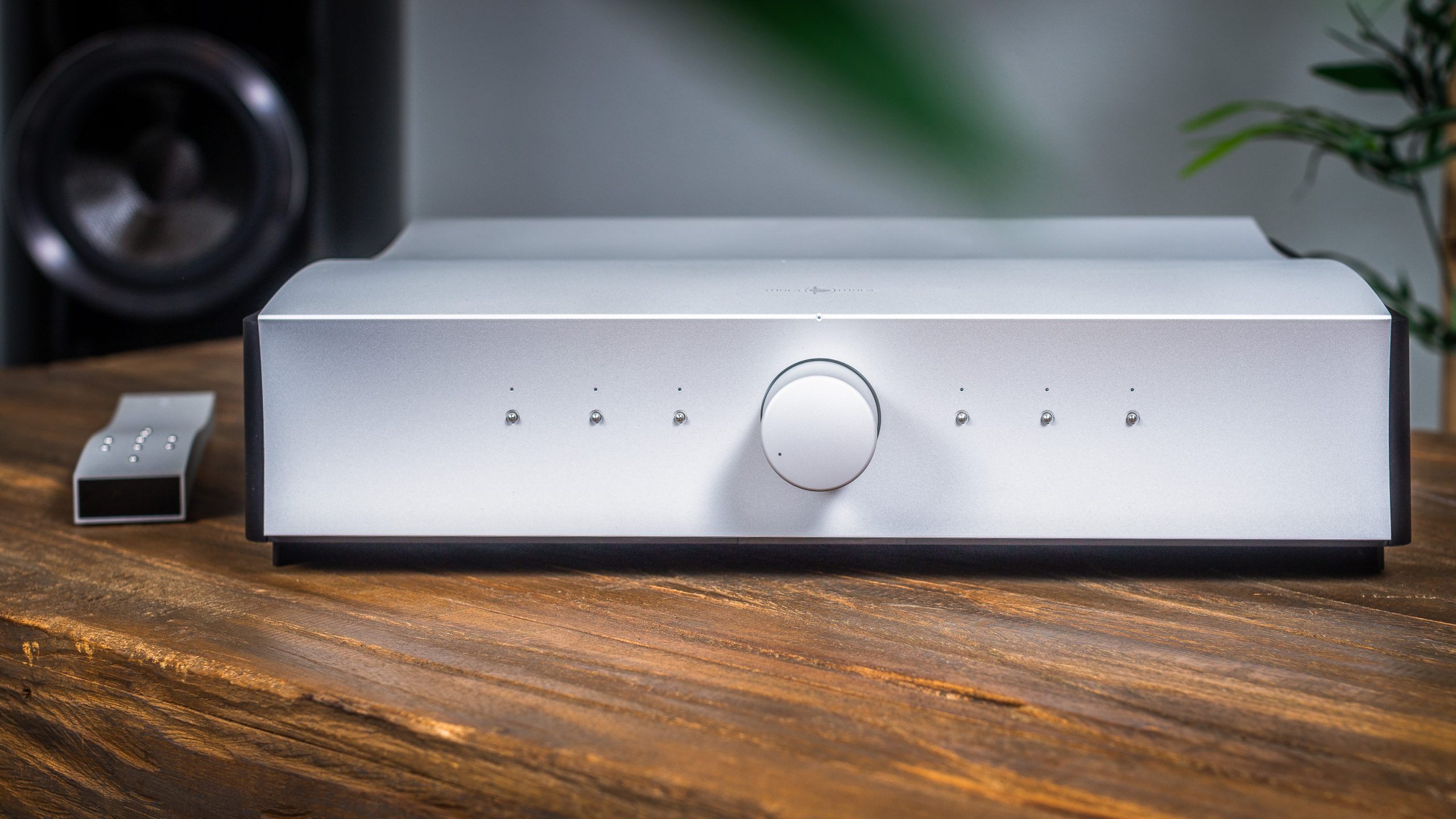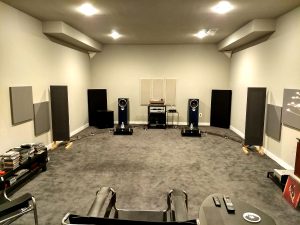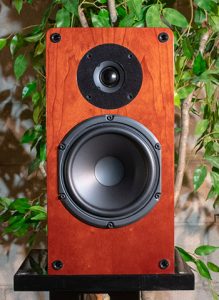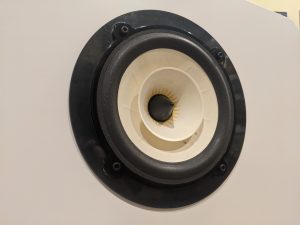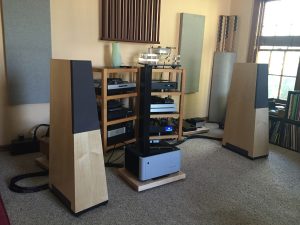Great First Impressions
I'll never forget the look on Greg Weaver's face the moment he and I got to hear (at the AXPONA 2018 high end show) what Studio Electric and chief designer Dave McPherson's latest thinking on what small loudspeakers, the diminutive M4, could do. Greg had that classic "I told you so" grin on his face, one that seemed to say, "Dude, can you believe how good this thing sounds?" a few seconds after Dave lowered the stylus of what I think was a Hana MC cartridge (here tethered to a Fern & Roby turntable/arm combo with ModWright Instruments supporting electronics) into the lead groove of Janis Ian's dark reflections on the Holocaust "Tattoo," from her seminal 1993 release Breaking Silence.
As some of you may know, Greg, who writes for this journal, The Absolute Sound, and Enjoy the Music, is one of my closest audiophile buds. Because I was not familiar with Dave McPherson's work, Greg suggested that we visit the Studio Electric suite as a destination room. For his part, Greg knew what to expect before we arrived, but I was totally clueless. Had my good friend not insisted, audio snobbery probably would have motivated me to overlook this room altogether. After all, how much could one expect of a 19 lbs mini-monitor priced around $2.4K, and from a company that I knew almost nothing about?
Turns out that it was Dr. Weaver who had the last laugh. What I heard in the Studio Electric suite forced me to recalibrate what one can and should expect from a $2.4K box speaker, making the M4 demo one of the unqualified highlights of the entire show. Here, I opined enthusiastically in my follow-up show report, was a sensibly-priced compact loudspeaker that punched way above its weight class dynamically, reproduced the power range with genuine authority, and delivered marvelously detailed, spacious, naturally unforced sound. The "Tattoo" cut soared effortlessly in the demo room, but with gravitas and scale, while Tomasz Stanko and team (one of my go-to show demo ensembles) filled the back third of the room with densely layered, warmly textured hues.
Following AXPONA 2018, I immediately reached out to Dave to request a review pair. Dave was only too happy to oblige and promptly arranged shipment of a lovely pair of brand-spanking new M4s. My pair arrived a couple of months later, smartly packaged in a large double-layered cardboard container, and finished in a beautiful wenge veneer. Unfortunately, Dave could not provide my first choice, a sumptuous figured maple veneer wrap, as that option has been in exceedingly short supply due to high demand.
Image by Maurice Jeffries
Nuts and Bolts
Sealed box affairs with cabinets constructed of a combination of strategically braced MDF and HDF panels, the M4s boast an amp-friendly 88dB sensitivity rating, a benign 6 Ohm impedance, and an impressive 44Hz - 22kHz frequency response. Employing a custom crossover, a 6.5" proprietary copolymer woofer, and a 1" soft dome tweeter that together seem capable of handling hundreds of watts of power without strain, the M4s can rock. Surprisingly, the speakers are quite tiny. They measure a scant 13"H x 8.625"W x 13.5"D (sans grills), weigh a modest 19 pounds each, and sound best if stand-mounted.
As small box speakers go, the M4 is pretty darn cute, if lacking in external bling (the lovely grills notwithstanding), and expertly constructed.
Dave was kind enough to send the optional stainless-steel wire mesh grills with the speakers. These elegant grills, fabricated from the same material used on the wind screens of professional microphones, are real eye-catchers. I'm not sure I would pop for a pair if I were consigned to a small listening room that no one else in the house used, but I will say that I detected little difference in the speaker's sound with the grills on versus off. They are as close to invisible a grill as I have heard (or not).
Because of their petite stature, the M4 requires a well-designed stand to perform at its best. Dave does not recommend bookshelf placement. At his suggestion, I ordered a pair of 28" tall Pangea Audio DS400 speaker stands from Audio Advisor. The Pangea stands placed the M4 tweeters at roughly ear height at the listening position. I toed the speakers in so that I could just see the veneering of the inward-facing side panels, better to balance width and depth cues, and to maximize imaging specificity. This setup delivered the most focused sound overall, maximizing inter-driver coherence and fleshing out properly the tricky upper midrange/lower-treble transition region.
Defying the Physics of Small Boxes
Seemingly defying the laws of physics, the diminutive M4s project a sound all out of proportion to their compact dimensions. All things being equal, one can only generate so much deep bass content from a small sealed box speaker. As Stereophile editor-in-chief John Atkinson noted in his famous review of the demure Celestion SL700 loudspeaker, "for a given cabinet volume, gains in low-frequency extension have to be balanced against corresponding drops in sensitivity, and it is quite possible that to go for 20Hz extension will result in a 60dB/W/m sensitivity, equating with a speaker that only plays extremely quietly, and thus of no use to anyone." (HERE).
In other words, skillful designers can tease additional low-end reach out of a small box by sacrificing overall speaker sensitivity, but this often results in unsatisfactory dynamic range limits. Stout drivers able to absorb high power levels can overcome the low output problem to a degree, but one is still left with a speaker that must be driven with enough watts to generate acceptable sound pressure levels. This typically means at least 100 or more watts per channel. The ATC sealed box monitors adhere to this low sensitivity-deeper bass paradigm, as did the fabled Celestion SL series of sealed box loudspeakers back in the 1980s.
The M4 doesn't eschew this formula entirely with its 88dB sensitivity rating, but this figure is considerably higher than either the ATC average (approximately 84dB @ 1W at 1meter) or the Celestion SL600 and 700 figures (approximately 82dB at 1W @ 1meter). What this means is that the M4 can generate satisfying sound pressure levels without the need for a gargantuan amp. I obtained excellent results with the new Parasound HINT 6 integrated amplifier (160 watts into 8 ohms—review forthcoming) and teased out decent sound from the 35 watt per channel tubed Mastersound BoX integrated (review also forthcoming). At AXPONA 2018, Dave paired the M4 with the ModWright KWA 150 power amp (150 watts into 8 ohms) to outstanding effect, as I noted in the opening paragraphs of this review.
With the M4, raw power is important, but so too is quality.
Properly fed, these dwarfs energize the listening space with convincing authority, laser-sharp focus, and hammer-fisted dynamics. Their essentially neutral tonal balance and praiseworthy timbral precision grounds instruments and voices with earthy traction, making it all too easy for listeners to suspend disbelief and imagine, for more than fleeting seconds, that they are hearing the real thing.
Uncanny soundstage width and depth scaling coupled with eerily precise image focus leaves an indelibly rich sonic impression. Rarely have I heard a speaker that approximates, let alone rivals, the imaging prowess of these little numbers. They possess the uncanny ability to cast instruments and voices in holographically stark relief, but absent the bête noire of most small speakers: the annoying miniaturization of instruments like piano and tympani, along with greatly diminished sonic scaling, and bleached tonal and timbral colors.
Classical works benefit immensely from this imaging precision and realistic soundstage scaling. On a densely scored work like Boulez's Pli Selon Pli (Pierre Boulez: Pli Selon Pli (Sony Classical)), individual voices and instruments, and instrumental clusters occupy their own distinct ambient pockets, yet remain tethered temporally, dynamically, and tonally to the rest of the ensemble. This cut-from-whole-cloth perspective allows one to savor each distinct vocal and instrumental strand, yet not lose track of the work's brooding gestalt.
Dynamic scaling is another M4 strength. Given their decent sensitivity rating, this loudspeaker plays convincingly at lower volume levels. More impressively, the M4 handles dynamically demanding material effortlessly. Dynamic crests hit with the impact and force of a Category 3 hurricane (I should know. I live in Florida.) Big bands growl and wail with the necessary drive and associated scaling to fill the back wall of my compact listening room with precisely mapped, but also realistically scaled, solo and clustered instruments, again with overall instrumental tonalities and timbres intact. Just put a dynamically robust big band disc like the 1972 barn-burner Thad Lewis & Mel Jones: Suite for Pops (A&M) on your turntable to hear what I mean (the disc's noticeable electronic manipulations and apparent bass compression notwithstanding).
Musical transients, both hard and soft, strike with lightening quickness and an associated cleanliness of presentation that seems the sole province of well-designed sealed box speakers. If you own a good turntable/tonearm/cartridge combination and a quiet, well-behaved phono stage, the M4s may strike you as something of a Godsend. Their transient precision, micro-dynamic fluidity, imaging prowess, and impressive scaling play remarkably well to vinyl's core strengths: musical flow, imaging and soundstage integrity, and tonal naturalness. The M4s are to vinyl playback rigs what tubes are to horn loudspeakers.
Voices really shine over this speaker. The transition between the excellent mid-bass driver and the soft-dome tweeter is handled superbly, with no hint of the tweeter shouting over and above the mid-bass unit, nor the latter booming and chuffing beneath the former. On Diane Krall's 2004 Verve CD release The Girl in the Other Room (Verve 2004), my copy burned to hard drive and played over my Lumin D1 server/Cambridge Audio DAC combo, the singer's raspy-sweet voice floats effortlessly between and just above the two loudspeakers, her cappuccino-tinted inflections reproduced to thrillingly natural effect. Playing the disc from start to finish, I could detect no obvious tonal aberrations and observed no discontinuities between the soft-dome tweeter and the polypropylene mid-bass driver.
On balance, the all-important midrange comes across as highly linear with very good transparency and excellent overall coherence.
The top-end possesses just enough finely filigreed air and openness to capture that top-end "sparkle" audiophiles crave, if not quite rivaling the best beryllium and ribbon tweeters for sheer speed, air, and to-the-heavens extension. On the Krall disc, the speaker captures enough of the that ineffable sense of ambient and airy "moistness" to bring this all-digital recording to vibrant, pulsating life.
The M4's bass response deserves special mention. Not only does this speaker dip well into the low 40s in sheer low frequency extension terms (with the added gentle sealed-box LF roll-off likely delivering useful bass reinforcement below that figure, albeit well down in level), it does so with exceptional precision, speed, and tautness. If you're like me and love well-recorded acoustic jazz, and well-recorded acoustic bass, the M4s will leave you wide-eyed and giddy.
Perhaps more importantly, you may find that you can dispense with a subwoofer altogether. The M4's precision, speed, and class-leading low-end articulation means that it sounds convincingly full and extended to satisfy on most fare. Mind you, if you are a listener that simply must have your pop and rock classics reproduced at near concert hall levels, you will need a well-designed sub to achieve the desired deep bass reach and eardrum-splitting SPLs. For the rest of us, the M4 digs deep enough to banish any thoughts of augmenting its remarkably coherent sound with a subwoofer.
Parting Thoughts
At the price, I don't have much to criticize. However, a couple of chinks in the speaker's armor emerged during the review. Occasionally, and when pushed too hard, the sound can harden a bit in the upper midrange, lower treble region. To be fair, I noticed this coloration more frequently in the early weeks of the review cycle versus later, suggesting that at least part of what I was hearing related to insufficient driver break-in. Over time, this coloration largely vanished, but not entirely.
I think a bit of box-induced resonant behavior may be the culprit here, which makes perfect sense. At its $2400 asking price, one cannot expect the monumental cabinet bracing that one sees in my $10K/the pair reference Von Schweickert Audio Unifield 2 Mk.III loudspeaker, perhaps the most fanatically braced small speaker cabinet I have encountered in my many years as an audiophile.
In the sub-$5K price arena, a designer must choose design compromises carefully. Here, I suspect that less than state-of-the-art cabinet bracing fell by the wayside to bring the M4 in at the desired price-point.
The other point to make here has to do with bass loading. Listeners more accustomed to the fuller-than-life low end bloom of some bass reflex designs may not take to the M4's sealed box bass alignment and utterly different sonic presentation, at least initially. I am a longtime sealed box fan, so I pretty much knew what to expect (and not) down below. But, if you prefer the warmish, bubbly sound of some bass-reflex designs, then the M4 may strike you as a bit lean in the lower registers.
Image by Maurice Jeffries
In my experience, the speakers do "open up" both tonally and dynamically given enough break-in time (around 100 hours), and ultimately bloom with commanding presence over the entirety of their useful frequency range. Still, some may prefer the fluffier charms of bass-reflex designs to the tonally more focused perspective one hears in a well-designed sealed box.
For the rest of us, the M4 offers all that any sane listener will likely ever want or need. They look great, sound fantastic, and won't jeopardize financially what remains of your household's marital or partnership bliss. They are as near to perfect a small speaker as I have encountered, certainly at anywhere near their very fair asking price, and can give certain wee boxes from across the pond (sealed and bass-reflex) a real run for their money.
That is a Brexit deal worth embracing, I'd say.
Highly recommended and quite the exceptional value.
Studio Electric M4 Monitor Loudspeaker
Retail: $2400 the pair (wenge finish; speaker stands not included)
Studio Electric LLC
801.450.0633
All images courtesy of Studio Electric LLC unless otherwise noted.




